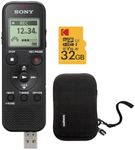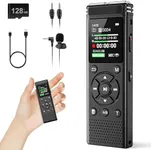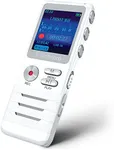Buying Guide for the Best Sony Voice Recorders
When choosing a Sony voice recorder, it's important to consider your specific needs and how you plan to use the device. Whether you're a student needing to record lectures, a journalist capturing interviews, or a musician recording ideas, understanding the key specifications will help you make an informed decision. Here are the main specs to consider and how to navigate them to find the best fit for you.Recording QualityRecording quality is measured in bit rates and sample rates, which determine the clarity and detail of the audio. Higher bit rates and sample rates mean better sound quality. If you need clear, high-fidelity recordings, such as for music or professional interviews, look for a recorder with higher bit rates (e.g., 192 kbps or more) and sample rates (e.g., 44.1 kHz or higher). For general note-taking or lecture recording, lower bit rates and sample rates (e.g., 64 kbps, 22 kHz) may suffice.
Storage CapacityStorage capacity determines how much audio you can record before needing to transfer or delete files. Voice recorders come with internal storage and often support external memory cards. If you plan to record long sessions or high-quality audio, look for a recorder with larger internal storage (e.g., 4GB or more) and the ability to expand with microSD cards. For occasional use or shorter recordings, smaller storage may be adequate.
Battery LifeBattery life indicates how long the recorder can operate on a single charge or set of batteries. Longer battery life is crucial for extended recording sessions or when you don't have easy access to charging. If you need to record for long periods, look for a recorder with a battery life of 20 hours or more. For shorter, intermittent use, a recorder with a battery life of 10-15 hours may be sufficient.
Microphone QualityThe quality of the built-in microphone affects the clarity and range of the recordings. Some recorders have stereo microphones for capturing more detailed sound, while others have mono microphones. If you need to capture nuanced audio, such as music or interviews, look for a recorder with high-quality stereo microphones. For basic voice notes or lectures, a mono microphone may be adequate.
File FormatsVoice recorders save audio in different file formats, such as MP3, WAV, or WMA. MP3 files are compressed and take up less space, making them suitable for long recordings. WAV files are uncompressed and offer higher quality but take up more space. Choose a recorder that supports the file format that best suits your needs. For high-quality recordings, WAV is preferable, while MP3 is good for longer, less critical recordings.
ConnectivityConnectivity options, such as USB ports or Bluetooth, determine how you transfer recordings to other devices. USB connectivity is common and allows for easy file transfer to a computer. Bluetooth can be useful for wireless transfer to smartphones or tablets. If you need to frequently transfer files, look for a recorder with reliable and convenient connectivity options.
Size and PortabilityThe size and portability of the voice recorder can affect how easily you can carry and use it. Smaller, lightweight recorders are more portable and convenient for on-the-go use. If you need a recorder that you can easily carry in your pocket or bag, look for a compact and lightweight model. For stationary use, such as in a classroom or office, size may be less of a concern.





















